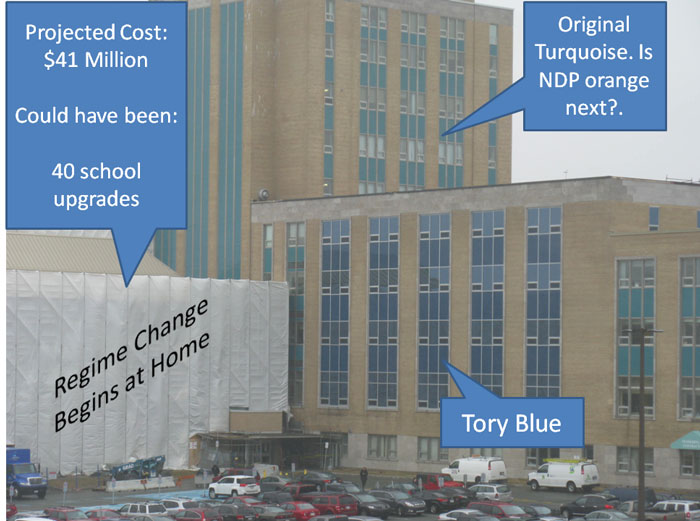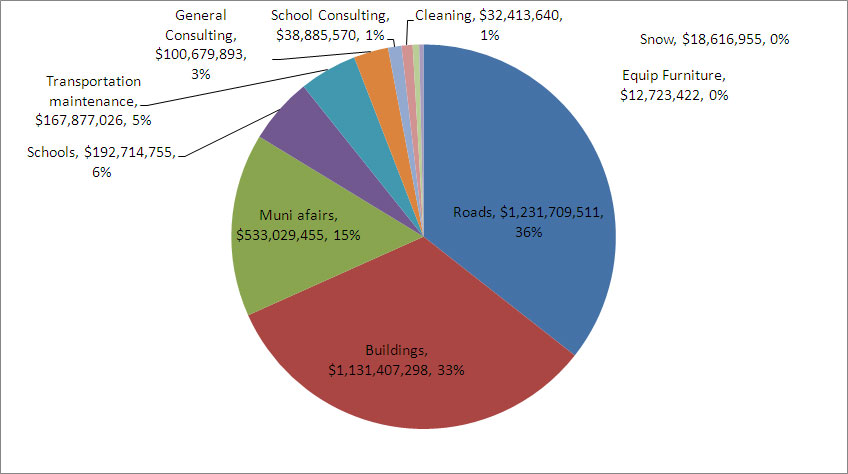- Home
- Deceptions
- Solar
- Thermal Audit
- Ventilation
- Sensors
- Governance
- Environment
- Reference
- Contact
- News
The Cost of Infrastructure in
Newfoundland and Labrador
[Return to Policy Summary Page]
It is worthwhile taking a look at some projects so that things can be put in perspective.
Here are the most expensive projects in recent years with the cost in millions.
| Project Description | Cost |
|---|---|
| Carbonear Long Term Care Project | 73 |
| John's Long Term Care, West Patient Tower | 68 |
| Labrador West Health Care Facility | 56 |
| St. John's Long Term Care - East Patient Tower | 53 |
| Design-Build Contract,Corner Brook Long Term Care Facility | 50 |
| Building Envelope Upgrading East Block, Confederation Building | 41 |
| Construction of a new vertical lift bridge | 40 |
| Main Building Contract, The Rooms, St. John's | 34 |
| Redevelopment of RNC Campus | 31 |
| New K-6 Schools for Torbay and Paradise | 28 |
| Summer and Winter Maintenance on 570 km of Roads and Bridges on R510, Labrador | 22 |
Note that most of the large projects are health care related. Roads cost about 1/4 million per kilometer to grind and surface. The Building exterior upgrade for the Confederation building is worth a look -- drive around the back of the building and see for yourself what $41 million gets you. The Tory blue panels are new, the turquoise panels are the original. Perhaps, but the time it is finished, the remaining panels will be red or yellow.

It is immoral to cut projects that benefit ordinary people in important ways (maintaining schools, providing employment assistance, building affordable housing) while wasting far more on vanity items. So the next time you hear that we can't afford a million to upgrade a school -- ask yourselves how can we afford 40 times that amount for the exterior of a political office building?
Lets take another look at infrastructure expenditures over the last few years, this time by category.

Roads are very expensive to maintain, especially when there is no railway to take the heavy loads.
In many parts of the USA, governments are letting their paved roads revert to dirt because they can't afford to maintain pavement. Roads to Ruin: Towns Rip Up the Pavement, Making a rural comeback: The old gravel road .
It is unfortunate that our low speed narrow gage rail system was abandoned since passenger traffic alone would have minimal wear on the highway system. Studded snow tires are banned almost everywhere except Newfoundland because it costs excessive maintenance costs.
Buildings are the second largest expense category, and the most expensive buildings are hospitals. Municipal affairs are things like "Sewage lift station upgrade, Town of Ming's Bight". This is an important category since neglect here and everything falls apart.
Corner Brook Long Term Care Facility
Since this facility is one of the most expensive project in recent times, it is worth looking at the breakdown of contracts:
$28,2751 22/07/2005 Site Preparation - Corner Brook Long Term Care Facility (LTC) SGE ACRES LIMITED
$2,068,685 16/01/2006 Corner Brook Long Term Care Facility, Construct New Facility HEARN FOUGERE ARCHITECTS, JOINT VENTURE
$50,749,469 14/02/2007 Design-Build Contract,Corner Brook Long Term Care Facility POMERLEAU INC
$72,327 09/12/2008 Leed Verification and Certification Services, Corner Brook Long Term Care Facility ENERMODAL ENGINEERING
$5,414,077 23/04/2009 Purchase of Furnishings and Equipment for the new Corner Brook Long Term Care (LTC) Facility. WESTERN HEALTH CARE CORP
29/07/2011 LEED Energy Modelling - Corner Brook Long Term Care Facility AMEC AMERICAS LIMITED
All these values are subject to increase via change orders and represent a minimum cost.
We need a consensus on infrastructure priorities.
Suggestion for Discussion:
Sacrifice: Paving the Labrador highways for now, allow some paved roads to revert to gravel, ban studded snow tires, stop building monuments like the Rooms and face lifts for government offices, outsourcing routine work to high priced external consultants. Most of the reductions are going to have to come from roads and buildings since they account for 69% of expenditures.
Gain: Repair water supplies and sewer facilities, update all schools, build affordable apartments, build and staff medical clinics, upgrade hospital equipment, add full day kindergarten.
Town Planning and Building Codes
A number of architects have come to Newfoundland and given presentations on planning issues - and a common theme is that the province needs to take it seriously or else suffer the fate of every other unplanned metropolis.
Builders are not going to do anything that doesn't increase profit. To counter destructive greed and to ensure communities are sustainable, you first need a clear vision, and then develop a set of policies to achieve these goals.
The Vision
- Homesteads are affordable (e.g. you can own them outright within 20 years or less) with the average income.
- Homes are cheap to operate (low heating costs) and maintain (best building practices enforced)
- Owning a car is optional. Schools and basic services within walking distance
- Employment integrated into the community with a mix of residential and commercial (not zoned bedroom commuting commutities)
Example Policies
- Use layouts for subdivisions so that all homes face south to cut down on heating costs.
- One roof face should also face south to support optional solar panel installation.
- Mix residential with commercial properties. Every sub-division should have walking paths to a plaza that has small businesses (food, restaurant, miscellaneous services). Mixing residential and commercial properties allows many people to live near their workplaces and reduces commuting significantly.
- Homes are far too expensive to heat, and if power rates double, many people are in trouble. The province should build a reference home using solar passive techniques and local materials where possible. Plans would be freely available, and the heating costs in energy per square meter per year would become the new standard to meet. This would ensure that all new housing stock would be affordable to operate by the current and future owners.
- Set and enforce window installation standards. Very few builders bother following the manufacturers recommendations. Most new homes will leak within 10 years and the walls will rot with fungus and mold.
- Insist that a minimum proportion of homes be slated for affordable housing. These could be well designed town houses or small apartment blocks. This proportion should reflect the demographics.
- Ban electric resistance heat except for ultra efficient buildings that need very little extra heat. Demand heat pumps, solar or pellet stoves.
- Monitor ground water well drilling carefully. The Avalon does not have an aquifer so well water comes from cracks. It is possible for one well to drain others leaving homes with no water supply.
